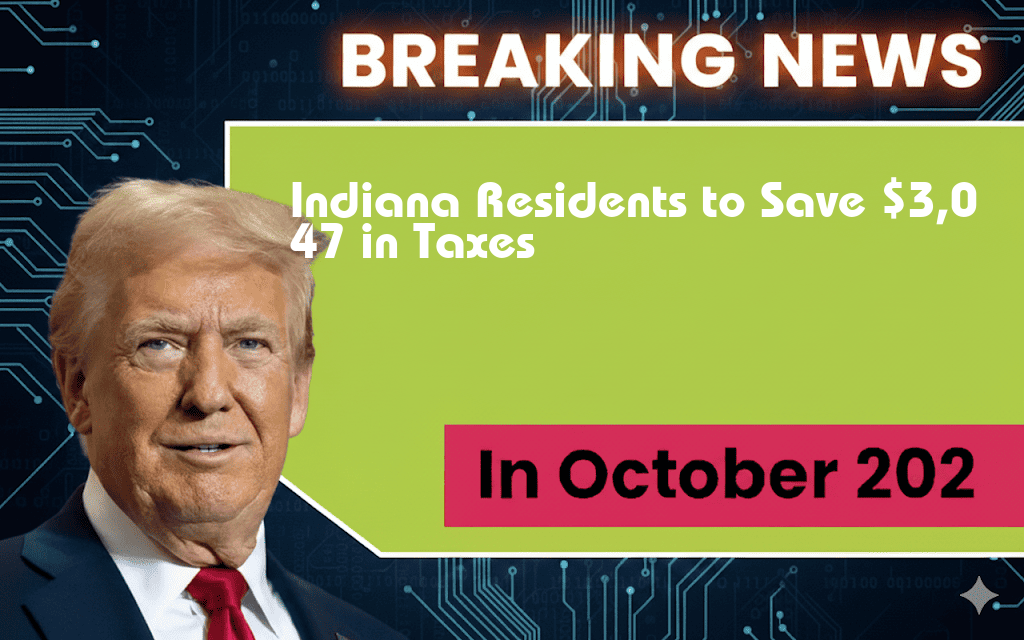Indiana Residents Set to Save $3,047 in Taxes by 2026 Thanks to New Legislation
In a significant move aimed at easing the financial burden on Hoosiers, Indiana lawmakers have approved new legislation that could save residents an estimated $3,047 in taxes by 2026. This measure, which was signed into law by Governor Eric Holcomb, focuses on reducing income taxes and offering relief to families and individuals across the state. The initiative comes at a time when many residents are grappling with rising living costs, and it is expected to provide much-needed financial relief for the middle class in Indiana.
Details of the Legislation
The new tax reform plan includes a series of changes to Indiana’s income tax structure. Key components of the legislation are:
- Reduction of the State Income Tax Rate: The state income tax rate will drop from 3.23% to 3.15% over the next five years.
- Increased Standard Deduction: The standard deduction for individuals will rise to $1,000, while married couples filing jointly will see their deduction increase to $2,000.
- Tax Credits for Families: Families with children will benefit from enhanced tax credits, making it easier to manage the costs associated with raising children.
Projected Impact on Residents
According to the Indiana Department of Revenue, the average taxpayer could see a reduction in their annual tax liability of approximately $600 by 2026. This figure takes into account the cumulative impact of the tax rate decrease and the increase in the standard deduction. As a result, households are expected to experience a significant boost in disposable income, allowing them to allocate funds toward savings, education, or home improvements.
Support and Opposition
The legislation has garnered support from various political and economic sectors. Proponents argue that these changes will stimulate economic growth by encouraging spending and investment among residents. “This is a win for families and a win for our economy,” said State Representative Timothy Brown. “By putting more money back into the pockets of Hoosiers, we are fostering a more robust economic environment.”
However, not all voices are in agreement. Critics of the legislation caution that the tax cuts may lead to reduced funding for essential public services, such as education and infrastructure. They argue that while the short-term benefits are clear, the long-term implications could strain the state’s budget. “We need to ensure that we are not sacrificing critical services for short-term relief,” stated State Senator Karen Tallian.
Economic Context
These tax reforms come as Indiana’s economy continues to recover from the impacts of the COVID-19 pandemic. According to the U.S. Bureau of Economic Analysis, Indiana’s GDP grew by 6.5% in 2021, reflecting a strong rebound. The state has also seen a decrease in unemployment rates, which currently stand at 3.1%, well below the national average.
As Indiana moves forward with these tax reforms, residents are left to ponder how these changes will affect their financial situations in the coming years. Many are optimistic about the potential savings, while others remain cautious about the long-term effects on public services.
Looking Ahead
As the state implements these tax cuts, it will be crucial to monitor the impact on both the economy and public services. The Indiana Fiscal Policy Institute has indicated that an ongoing assessment will help ensure that the benefits of these tax cuts do not come at the expense of vital state services.
For Indiana residents, the promise of tax savings is a welcome prospect in challenging economic times. As they prepare for a future with potentially more disposable income, the focus remains on balancing growth with the needs of the community.
For more information on Indiana’s tax reforms, visit the [Indiana Department of Revenue](https://www.in.gov/dor/) or read more about the economic outlook on [Forbes](https://www.forbes.com/).
Frequently Asked Questions
What is the main benefit of the new legislation for Indiana residents?
The new legislation allows Indiana residents to save an estimated $3,047 in taxes by the year 2026.
How will the tax savings be implemented?
The tax savings will be implemented through a series of gradual tax cuts and adjustments to existing tax policies as outlined in the new legislation.
Who is eligible for the tax savings in Indiana?
All residents of Indiana will be eligible for the tax savings, which are designed to benefit individuals and families across the state.
When can residents expect to see the tax savings take effect?
The tax savings are expected to take effect progressively, with the full benefit realized by 2026, following the implementation of the new legislation.
What other benefits does the legislation provide besides tax savings?
In addition to tax savings, the legislation aims to enhance overall economic growth in Indiana by encouraging investment and supporting local businesses.

Leave a Reply